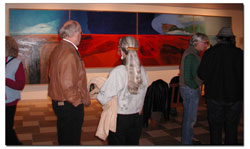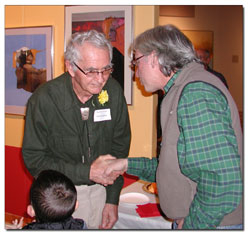| ||||
Deep space
by Jules Masterjohn When you walk through the gallery doors of the Anasazi Heritage Center in Dolores, the first thing you notice is color. Big, bright areas of bold hues are found on every wall. This is not surprising given that the exhibiting artist, Stanton Englehart, is known for creating colorful canvases. He is also known for his depiction of the landscape. Within the four sides of his stretched linen canvas, a slice of the world is pictured with its bit of earth and sky joined firmly at the horizon. This expansive view of the landscape is familiar for those of us living on the Colorado Plateau, the place that inspired Englehart for nearly 60 years of his prolific artistic career. His painting, “Seasons on the Plateau,” which is prominently displayed in the exhibit and is the title of the show, seems to tell it all. Nearly 24 feet long and 7 feet high, it is as if the wall opened itself up to reveal the artist’s chosen world – one composed of hot reds and cool blues. In this painting, realism flirts with abstraction. Broad, expansive horizon lines intersect with erect forms in the landscape. The viewer is pulled into the created by the convincing use of linear perspective. As is characteristic of Englehart’s compositions, the viewer is placed slightly above the scene, seeming to hover in the sky. Simultaneously, one’s gaze is pushed back and held firmly to the surface of the canvas, achieved through the strategic placement of flat areas of color. This moving in and out, through the illusionary window onto the world, is reinforced by Englehart’s dynamic use of color. Walking into an Englehart exhibit, one would expect to see vibrant color and landscape images, many landscapes, and skyscapes, too. The muse of the Earth-Gaia spoke powerfully through Englehart, as he dedicated himself to a career as a landscape painter. What may be surprising to viewers are the dozens of figurative paintings also on display. Portraits of women and animals hang huddled on the gallery’s center walls. These figurative works hold an important place in Englehart’s artistic development. During his formal art studies at the University
of Colorado at Boulder, the young artist often drew from a live model, developing a keen eye for the portrayal of the female figure. This was also the turbulent ’60s. A time when Rachel Carson’s writings brought warnings of environmental degradation; the Civil Rights movement challenged the status quo and suffered violent consequences; and America lost her hopeful innocence with the assassinations of influential leaders. The Vietnam War continued even despite society’s outcry to end it. At the same time, feminism was raising its voice in outrage over the compromised position of women in society. These social issues provided fertile ground for the artist’s creativity. The Women Series, created in the late ’60s and early ’70s, is Englehart’s response to his growing social, political and environmental awareness. The works portray women’s faces and partial bodies rendered with delicate line work, sharing the picture plane with flat areas of color and geometric forms. In each painting, a lone female figure is compressed into a confined space, as guillotine-like forms, laser-beam lines and smoke clouds intersect with her partial body. Often, the figure engages the viewer with her gaze, imploring us to do something. For Englehart, women symbolize the Earth’s inherent fertility and generative force. Here, the female body, which has historically represented the idea of perfect beauty and femininity, is bald and dismembered, tyrannized by linear elements, and floating in a maelstrom of emptiness. Englehart explained, “I used the images of bound women to symbolically express my concern about damage to nature caused by the use of misguided technology.” In these emotionally powerful paintings, he expresses his feelings about a world gone awry. Animals, like women, share a narrative role in Englehart’s paintings. Having grown up on a homestead near Lewis, Colo., and lived in agricultural communities, farm animals were a part of his life. Englehart sometimes portrays animals within the landscape to lend a sense of scale to his paintings but more often uses them to symbolize the “follies of man.” Animals and their antics have made appearances consistently throughout his career, as allegories for human weakness, violence and naiveté. It’s as if the gallery installation is a metaphor itself, for what Englehart wants to bring to our attention. Placed in the center of the gallery, his small figurative paintings, whether depictions of victims or protagonists, represent the range of possibilities for human interactions. This intimate drama is surrounded, on all four walls, by his large landscape paintings, their eons-old beauty giving pause to our daily dealings. In this gallery, we human beings are held in a much broader and possibly all-encompassing perspective. • “Seasons on the Plateau” is on display at the Anasazi Heritage Center in Dolores through March 30. Gallery hours are 10 a.m. – 4 p.m. daily. Admission is free through February. Call (970) 882-5600 for more information
|



